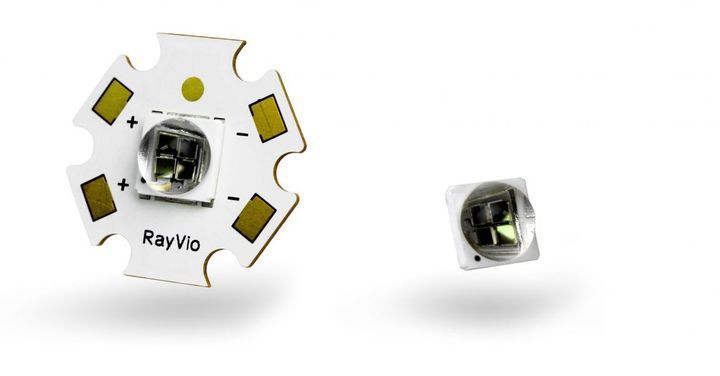
By Dr. Douglas A. Collins, CTO & VP of Engineering at RayVio
Microchips have fundamentally changed our lives over the last 50 years. Broadcast and communications, travel and transportation, business and finance, have all evolved over the years and have changed the fabric of our lives because of advances in microchips. Oddly though, microchips and the semiconductor revolution have not, to the same degree, become an integral part of our health and hygiene environment. At home and at hospitals, steam, sprays and wipes are the overwhelming tool of choice for disinfection. For hundreds of millions of people around the world, water is purified, when possible, with chemicals, machinery and even boiling. The advancement of health and hygiene technologies and practices is about to accelerate with ‘Microchips of Health’, purpose designed for both personal and professional products. Two of the first segments that will realize the impact of microchips of health are water purification and surface disinfection – both made possible with the most advanced LEDs emitting ultraviolet light.
1.5 Billion People and Counting
Water-related diseases affect more than 1.5 billion people around the world each year. In the United States, more than 1.7 million infections are acquired by patients while in a hospital, resulting in 99,000 deaths annually. It’s even worse in developing nations where approximately 10 percent of hospitalized patients acquire at least one hospital infection. In every case, the primary cause is the same. Bacteria. Even with all the disinfectants, pills and processes that have been developed, too many people remain at risk of illness or death.
The problems with many of today’s solutions are well understood: they’re too expensive, too large, are applied imprecisely or simply aren’t as effective as once thought. Consider the disinfectant sprays, wipes and hand sanitizers commonly used at home and in hospitals. Spraying and wiping a surface is an imperfect science. Anyone who has washed a car by hand on a warm summer day knows the frustration of seeing that one area on a door that your soapy sponge somehow missed. In a healthcare setting, the result of a missed spot is potentially a residue of bacteria that can be transferred to the next patient.
Bacteria, Ultraviolet Light and Disinfection
Ultraviolet (UV) light, in the form of mercury lamps, has already been tested in healthcare settings. The UV light has proven to be effective at fighting bacteria, but the lamps introduce a new set of issues. Aside from using mercury, which is highly toxic and must be disposed of carefully, the lamps are fragile, bulky and take up to fifteen minutes to power up.
UV LEDs that emit ultraviolet light at specific, effective wavelengths stand to change the potential of using UV light to fight bacteria. LEDs are already known to be very small, robust and long-lived, and with breakthroughs in power and intensity, the most advanced UV LEDs are now powerful enough to be integrated in lamps, wands and other solutions that can bathe a surface or an area with ultraviolet light and kill 99.9999 percent of bacteria in just seconds.
Companies are already exploring how these very small microchips can be integrated into the lighting of an exam room, an emergency room or even a surgical suite. And as with other microchip technologies, size, power and the ability to be integrated into other devices create new, explosive markets. For instance, it is relatively easy to add a UV LED to a smart phone. This would enable a flier to disinfect their seat tray table; a student could disinfect a desk; a parent could disinfect a countertop…or maybe even a child’s hands.
Clean Water
Accessing potable water is a global problem that to date has not been addressable with microchip technology. Here too though, advanced UV LEDs coming to market now have the potential to make potable water more available, and to help prevent millions of deaths each year.
Well systems could have UV LEDs integrated at multiple end-points to eliminate bacteria for a community. Even at home, UV LEDs are sometimes so small that they could be integrated into the faucets in kitchens and bathrooms, and even shower heads, for cleaner water. And in the event of a natural disaster that affects our water supplies, personal water disinfectants and bottles could reduce the demands on already stretched emergency services and provide safe drinking water for entire regions.
Microchip of Health
We have certainly seen the infusion of microprocessor technology into surgical devices and medical instrumentation, but until now, the use of advanced technology has been primarily limited to more expensive tools that require expert use. With the advances in UV LED technology, it’s clear that we’re on the cusp of bringing advanced health and hygiene solutions to consumers, as well as communities around the world that are in desperate need of cleaner environments and safe drinking water.
Dr. Collins is responsible for all aspects of technology and technology development across RayVio. Dr. Collins has more than 20 year of experience in semiconductor device design and development, encompassing epitaxial materials growth, device fabrication, manufacturing, test and reliability. He held a variety of positions at EMCORE, including Principal Scientist, reporting to the CTO. He has a Ph.D. in Physics from Caltech.
